|

US
Secretary of Defense - Chuck Hagel, now resigned. Who is next for a bit
of non-creative thinking?
They've
been at it since 1985 (see NY
Times article below), so why has it taken so long to develop drone
minesweepers? It beats the hell out of us. Seriously though, of course
we know the reason, it is because navies have always been slow to react
to problems, except in times of war. They don't spend time improving
efficiency because they like their big ships and smart uniforms. It's
traditional and tradition is what navies are all about. Not so most air
forces, because they operate at higher speed, pilot higher speed
vehicles and look to avoid mach 2 speed rockets.
On the ocean, it's a veritable holiday cruise, with speeds typically
below 20 knots and only infrequently above 30 knots in times of war.
That sedate pace coupled with the time it takes to build a ship,
ingrains itself in admiralty thinking. Thus, 20 years after drones were
looked into by the US Navy for mine clearance, and they are still
running about like headless chickens, with no clue as to a cure. Bring
on SkyNet
we say, with that kind of non-thinking, the machines almost deserve to
win. Check it out chaps, complacency is actually going backwards when
all around you there is progress.
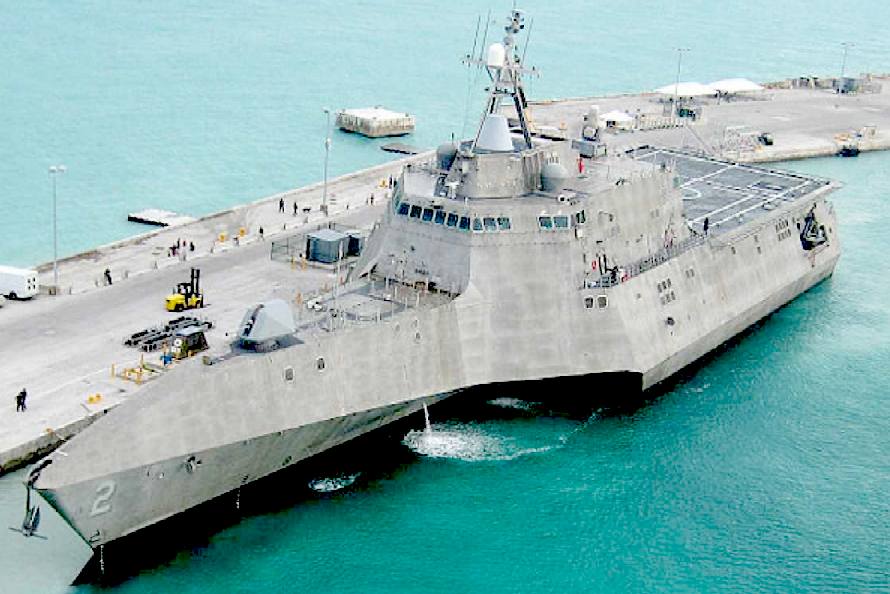
The
USS Enterprise, along with all of her sisters and brothers are at risk
from smaller cheaper weapons.
POPULAR SCIENCE NOVEMBER 2014 US NAVY WANTS ROBOT MINE SWEEPER TO PROTECT FRAGILE BOAT
Robots are at their best when doing jobs humans shouldn’t. Sometimes, this job means doing boring work, like slowly crossing the ocean recording data. Other times, this means looking for explosives under the water. The U.S. Navy’s Unmanned Influence Sweep System, or UISS, is a robot boat (or
roboat, if you will) meant to perform the latter. It is intended to go onboard the Littoral Combat Ship, stowed away most of the time and then released into the water near suspected minefields. The Navy plans on having a UISS prototype by 2016, with production models ready to deploy and use in 2019.
The Navy already has robotic boats of a sort. In August, they demonstrated swarms of boats, all converted to remote control, some even with degrees of autonomy, in a test on the James River. The converted boats were mostly patrol craft, designed for small
human crews. UISS, instead, will be a specially made craft, designed to coax sea mines into exploding before larger ships arrive.
UISS is a tool used by the Littoral Combat Ship, which itself is a new vessel procured by the Navy as a sort of floating jack-of-many-trades. The Littoral Combat Ship is designed to operate close to coasts and in shallower waters that larger naval vessels can't reach (that’s the “littoral” part of its name). The LCS is designed to do a variety of tasks that work better closer to shore, like fighting small boats, countering
submarines, and defeating underwater mines, and each of those tasks requires a special set of modules. The major problem with the "combat" part of its name ship is that it’s armor isn’t very good, but for many tasks, it doesn't strictly need to be. And for some of the others, there are
helpful robots that will do the job while the LCS is safely out of harm's way.
One of those jobs is minesweeping, and the UISS is how the LCS is going to defeat mines. The
minesweeper bot will drag a special cable over patches of mined ocean, trying to fool placed mines into thinking there’s a large ship above them so that they’ll detonate. These triggers can be magnetic or acoustic, and the planned UISS has ways of activating both. In addition to setting off mines, the roboats are supposed to withstand blasts, continuing forward until minefield is no more.
The project is in development now, so expect the navy of the future to protect itself with a ring of protective robots.
Popsci
Navy-wants-minesweeping-robot-boat-protect-their-fragile-ship
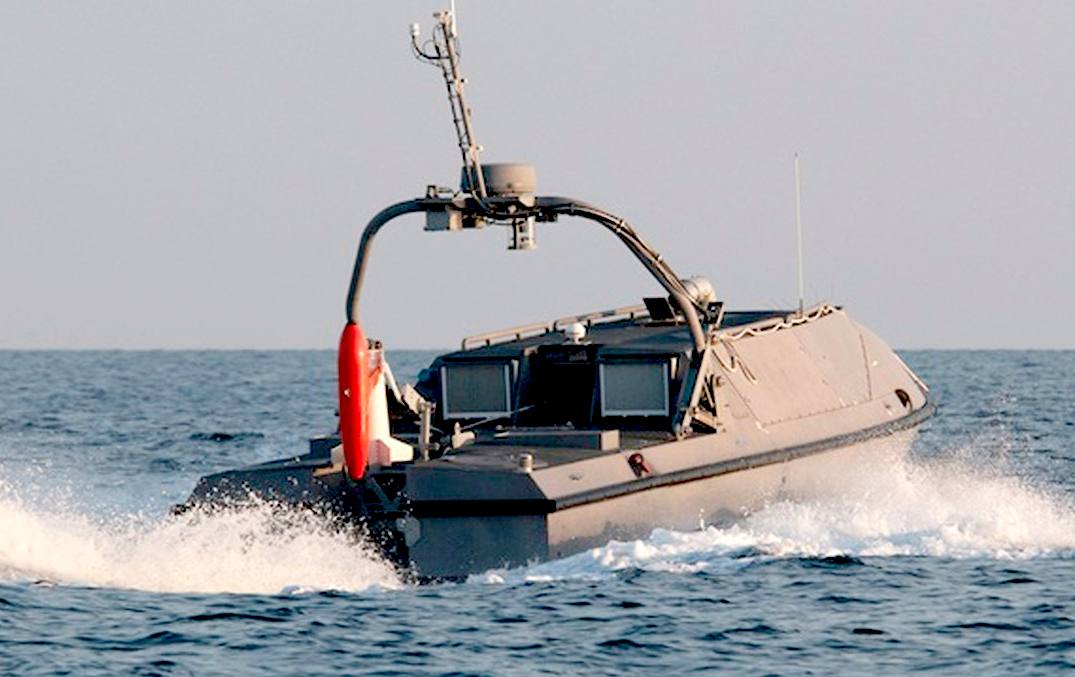
The
US
Navy is testing this craft. Is it the solution they have been seeking in
terms of cost effective mine clearances.
Not a chance! It is still labour intensive with very limited range.
Naval designers need to come to terms with the logistics of the
situation, before they get their computers out to see what little
modifications they can make to existing equipment to appease their
benefactors.
VICE.COM SEPTEMBER 2014 - US NAVY MAY USE QUADCOPTERS TO DESTROY NAVAL MINES
Naval mines are the proverbial red-headed stepchild of the naval warfare community. Generally neglected, sometimes abused, and seldom given any attention, they're a problem nobody wants to talk about. But they're also a problem that won't go away.
Generally speaking, naval mines function like their landlubber cousins. Except instead of being smallish things buried under some dirt that can kill or maim unwary soldiers and innocent civilians, or wreck a passing tank, naval mines can have warheads weighing more than 1,000 lbs., hide under hundreds of feet of water, and kill ships full of people. Even more frightening, some kinds of naval mines are essentially robot ambush torpedoes that lie in wait until they're activated by commotion from a passing vessel, at which point the mines launch themselves at high speeds toward the target and kill it.
Those are the Cadillacs of naval mines. The cheapest naval mines — the ones you tend to see bobbing in the ocean in movies, video games, and cartoons — are practically the IEDs of the sea, dirt-cheap and deadly. Those may cost only a few thousand dollars, while the Cadillacs cost a few million. Which is still way, way, way less than the cost of the ships upon which they prey; the US Navy's newest carrier, the
USS Gerald R.
Ford, cost nearly $13 billion dollars. (One mine wouldn't sink it, but it would quite plausibly disable and mangle the ship.)
Naval mines are extremely hard to neutralize once they've been laid. The costs of removing one can be anywhere from 10 to 200 times more than the cost of manufacturing and deploying it. Similarly, it can take 200 times as long to clear a naval minefield as it does to lay it.
During the Korean War, the North Koreans snuck out and laid a naval minefield that forestalled an amphibious invasion on Korea's eastern shore. It prompted Rear Admiral Allan Smith, who was in charge of that advance force, to
lament:
"We have lost control of the seas to a nation without a navy, using pre-World War I weapons, laid by vessels that were utilized at the time of the birth of Christ."
After World War II, efforts to clear remaining naval minefields resulted in the damage or loss of more than 500 ships. To this day, some of those
Second World
War era minefields — they contained thousands of mines — are still in place because it's too difficult or costly to clear them.
The most modern, high-tech, fancy US mine countermeasures still haven't really cracked the
de-mining code. The mine warfare module under development for the Navy's new Littoral Combat Ship is still very much under development, while more exotic programs using lasers (!!!) aren't fully mature. (There are no apparent plans in the works to mount lasers on sharks.)
Despite the relatively low cost and effectiveness of naval mines, most navies don't prioritize their use. First off, as good as mines are at messing things up, they make it hard to maintain control. It's the difference between assassinating somebody by shooting them at point-blank range, and assassinating someone by cutting the brake lines on his car. If you shoot him, you have a pretty clear idea of what's happening and when. But sabotaging the car won't work until he gets behind the wheel — and even then there's always the possibility someone else might get behind the wheel first, and then proceed to run over a kindergarten class.
Additionally, no navy can ever buy enough naval mines to prevent someone else from using naval mines. More enemy mines just mean more minesweeping ships. Most of the time, minesweepers aren't good at much of anything else, so most navies prefer to buy regular warships, which they can use to blow enemy minelaying vessels out of the water. They they just have to be really careful to not run into mines.
All of that said, the US Naval Surface Warfare Center's Carderock Division outside of
Washington DC may be on to something shit hot in the field of mine countermeasures.
At an exhibition last week, the Navy's mad scientists put out a bit of info about a new program to teach drones to hunt mines. It's both super clever and, in retrospect, why-didn't-I-think-of-that obvious. Take one cheap, commercially available quadcopter drone, add two very sensitive metal detectors, engineer it up, and presto — a mine-hunting drone!
Perhaps you've heard of drone swarms, the business of getting individual drones to fly together in coordinated formations to perform all manner of tasks. Since drones can be made to move in flocks, instead of one drone slowly sweeping a few feet of water at a time, the Navy could use tens or hundreds or thousands of drones to cover huge areas in no time flat.
The final ingredients are drone motherships. A lot of existing countermine technological development has been focused on advanced undersea robot drones tackling mines. They close in on a suspected mine, do final identification, neutralize the mine, and so on. But they're slow and they have limited sensor range.
The US Navy has been fooling around with putting some of those underwater robots on small boats, acting as motherships (motherboats?) that can transit to and from a minefield without setting off the mines, making it a lot easier to get the underwater robots to their mine warfare work sites without having to do the same with your nice new ship.
Here's the scenario: A ship lowers its drone motherboat into the water. The drone motherboat zips out to a minefield and deploys its flock of quadcopters, which quickly sweep a broad area for mine signatures. That info is relayed back to the motherboat, which in turn dispatches the slower, much more capable underwater robots to deal with each suspected mine individually. Or the drones may even vector in the underwater robots directly.
Ladies and gentlemen, boys and girls, children of all ages — I present to you a for-real, honest-to-goodness, "disruptive technology." A semi-autonomous, rapidly deployable, very fast littoral minesweeping system that effectively leverages existing legacy systems. This system relies on easily integrated heritage technology and low-cost commercial acquisitions, and will provide a littoral mine warfare solution.
Except of course for the complications that will need to be worked out. The system would involve real engineering, not just wild editorial speculation. It may not be of much use outside of shallow coastal waters — and any yahoo on the beach with an anti-tank missile could put a quick end to the whole floating robot menagerie. It also might be mostly worthless in anything but calm seas. And so on and so forth.
But solving those problems is what defense contracts are for.
News
Vice the-us-navy-may-battle-deadly-naval-mines-with-quadcopter-drones
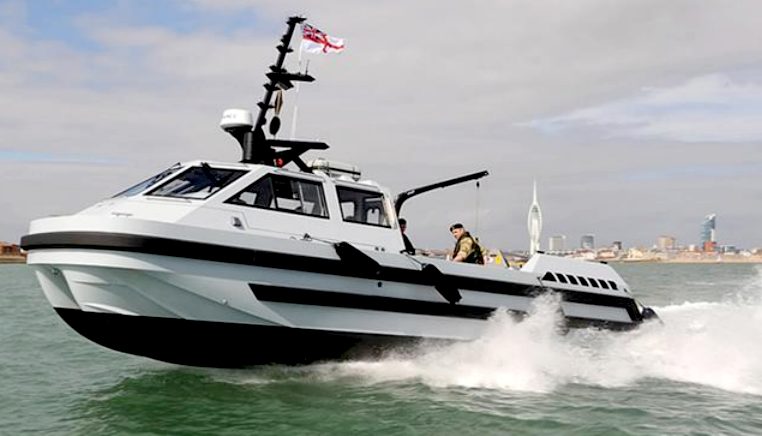
Royal Navy personnel with a submersible mine countermeasures vehicle onboard
'Hazard' a small, fast motor launch, capable of speeds up to 30 knots and able to be transported by an RAF Hercules.
Combat & Survival magazine believes that the ' HAZARD' is the Atlas Remote Combined Influence Minesweeping System (ARCIMS), made by Dorset-based Atlas Elektronik UK, which was displayed in the manned role at
DSEi in London's Docklands last September. For more on this craft and the others which took part in the Waterborne demo.
See the November 2013 issue of COMBAT & SURVIVAL Magazine. The immediate goal for the team is to fit this technology and unmanned sweep systems to a Hunt-class ship, but in the future the system could easily be run from any reasonable-sized warship, and sent anywhere in the world in just 48 hours.
(Original pictures
by Nicky Wilson).
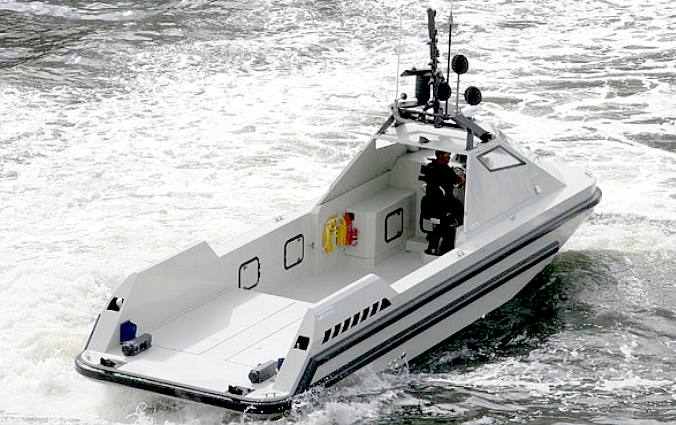
ATLAS ELEKTRONIK UK Ltd, based in Winfrith, Dorset is a leading provider of science and technology solutions to the UK Ministry of Defence, the Royal Navy and to other defence departments and corporate customers internationally. The business claims to have been at the forefront of UK naval research and development for over sixty years having its roots in the Admiralty Underwater Weapons Establishment
(AUWE) Portland. This boat carries either the bright yellow,
torpedo-shaped Remus 600, or the much smaller Remus 100, which are sent off to scan the seabed at depths of up to 600 or 100 metres, respectively.
After several hours submerged, scanning the ocean floor, the submersibles return to their mother ships and the data is then collected downloaded and
analyzed by the Royal Navy’s mine warfare experts. Imagine if such
data could be collected for days at a time and streamed back to GHQ
continuously, such as with a genuinely robotic vessel that did not need
to stop for crew to sleep, or to return to a land base to refuel.
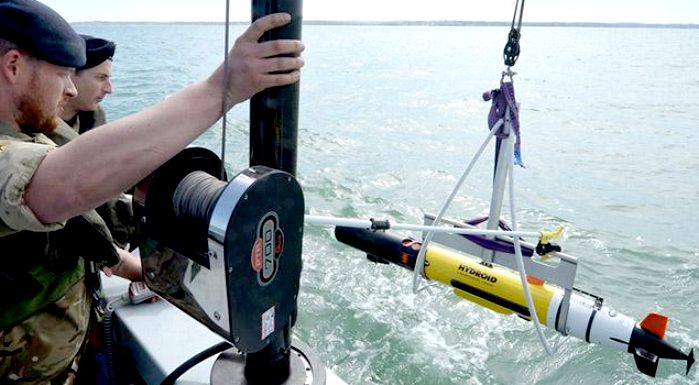
Sailors
launch a Remus semi-autonomous underwater vehicle from the Hazard. (Original
picture: Nicky Wilson).
A point of order here, with the press running rampant with certain buzz
phrases, we do not though quite understand how with so many crew
required for such operations, or indeed a refueling requirement, that
any of the vessels currently called 'autonomous' could carry that
distinction. Clearly, on the part of many journalists there is some
misunderstanding of terminology when it comes to military machinery and
public relations. The adjective 'autonomous' is explained in various
English dictionaries as being:
1.
Not controlled by others or by outside forces
2. To have true Autonomy a device would need to have a longer leash being able to complete complex missions without human intra direction. Such a system would say further automate the other elements of the total process making the whole of the "system" larger by including more devices that
multi-communicate with each other without involving ground based technicians or communications.
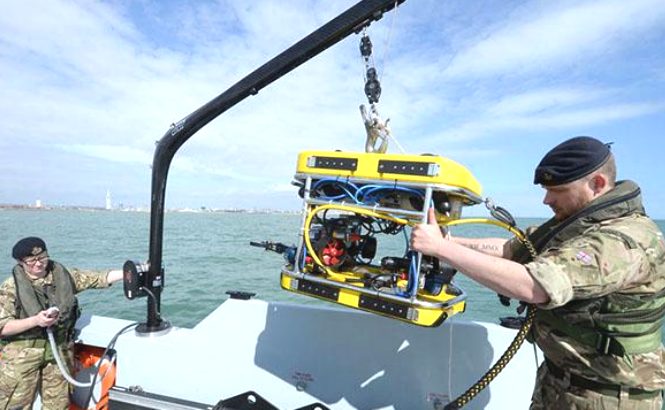
Royal
Navy personnel with a submersible mine countermeasures vehicle onboard
Hazard. As with the US Navy's boat of a similar design above, this
vessel presents no real solution to the longer term objective of ridding
certain key ocean areas of naval mines.
The motorboat, called Hazard, is currently being put through its paces by a specialist team of sailors in Portsmouth naval base. The boat can
act as the ‘mother ship’ to an assortment of hi-tech remote-controlled and robot
submersibles, provided that there is a crew onboard to launch and
recover the underwater vehicles.
The Royal Navy are quoted as saying "Collectively, they can search for, hunt and finally destroy mines faster than the Royal Navy’s Sandown and Hunt-class ships, and they also have the added benefit of keeping the sailors required to operate them out of harm’s way."
In view of the complications that appear obvious from these photographs,
that must be good news for aggressors, where at this rate the UK have
little chance of clearing new obstacles, let alone clear the backlog of
minefields.
The Maritime Autonomous System Trials Team (MASTT) is
a small Portsmouth-based Royal Navy unit testing the new unmanned systems.
Lieutenant Commander Jack McWilliams, the officer in command of MASTT,
is quoted as saying:
"This will be the seafaring equivalent of the unmanned aircraft which have revolutionised aerial warfare. It takes the sailor out of the minefield, but we are not taking them out of the equation. You will still need individuals with specialist mine warfare and hydrographic skills, a human being to identify a contact, but they will be much safer, and this is a much more effective way of doing our job.
This technology is fantastic, and we are right at the forefront of it. It is the future."
WIRED . CO. UK JANUARY 2013 - US NAVY TO BUILD ROBOT SHIP
The US Navy's next wave of robots will take on one of the most dangerous missions on the open water: destroying mines.
Anti-mine warfare is a critical mission for the US Navy, as nations like Iran can disrupt the global economy by threatening to plant mines in crucial commercial waterways. But the tools that the US Navy has to disable mines have a crucial weakness: they depend on humans getting too close to them for comfort. When it comes to blowing up, or "sweeping" mines, explains Duane Ashton, "There's a saying: 'Hunt if you can, sweep if you must.'"
Ashton, the US Navy's programme manager for its seafaring robots, has a different idea: let the robots do the dirty work. By April, he tells Wired, he hopes to solicit defence contractors to build something called the Unmanned Influence Sweep System, or UISS, a robotic ship charged with speeding out into suspected minefields and essentially fooling them into detonating them before they come in contact with a ship full of sailors. If the UISS works as intended, it'll be part of a fleet of near-future US Navy robot ships and subs designed to neutralise some of the most immediate threats on the high seas.
The idea is to launch the UISS from a Littoral Combat Ship, the new close-to-shore fighter that the US Navy wants to be the mine-stopper of the future, among its other missions. Currently, minesweeping is a task for manned ships and helicopters like the Avenger-class mine countermeasures ship and the MH-53 helo. "This would be the first unmanned sweep system [for a] surface capability," Ashton says, something "a lot of countries are looking at" but none have yet succeeded in developing. It works by playing a kind of practical joke on a minefield.
Underwater mines don't necessarily need to detonate on contact with a ship. Many explode when they sense the acoustic sounds that ships give off when passing through a waterway, or by detecting the magnetic signatures of the metals used to construct ships. So the UISS spoofs those acoustic and magnetic signals, getting the mines to "wake up," in Ashton's phrase
- that is, detonate - well out of range of a Littoral Combat Ship or other US Navy ship charged with keeping waterways mine-free. In 2011, testing in the
Florida waters with a 12-metre, remote-controlled UISS prototype proved that the robot's joke could get the mines to explode far from any sailor. Last week, in a much-anticipated step ahead of the UISS solicitation, the US Navy asked defence companies for their feedback on constructing the robot minesweeper.
There's long been concern about the ability of the new Littoral Combat Ship, whose missions include stopping mines, to accurately spot mines. Last year, the Pentagon's top weapons tester judged that the sensor and laser systems designed for the Littoral Combat Ship were " deficient" for their major mine-spotting task. And there's little margin for error: Mines are likely to blow the Littoral Combat Ship to bits if the UISS can't stop them.
But since the Littoral Combat Ship is designed to be modular - that is, to swap out its sensor packages when better ones come on-line
- the US Navy's response is to let the robots take care of hunting and sweeping mines. In April, it unveiled the Knifefish, an experimental, oblong underwater robot launched from a Littoral Combat Ship designed to hunt mines.
But the Knifefish can only find the mines. It can't destroy them. That's where the US Navy wants the UISS to come in. In principle, a controller aboard a Littoral Combat Ship will program the UISS out to steam out to a set of coordinates, possibly provided by the Knifefish, and from there it'll emit its spoof signals prompting the mines to detonate, and then swim back on its own to its mothership, which can rest easier knowing it won't be steaming into a minefield. Ultimately, the Navy wants 52 of the
robots, including training modules, so that every Littoral Combat Ship tasked with stopping mines carries a UISS.
The UISS and the Knifefish are part of a relatively new trend in naval robotics: unmanned ships and subs that can perform some of the Navy's most pressing and most dangerous missions. There's also the ACTUV, a project from the Pentagon futurists at Darpa, in which a semi-autonomous ship detects and hunts enemy submarines
- another high-stakes mission that counters one of the Navy's most immediate threats. Previous Navy robotics projects have either taken to the skies, like with carrier-based drones or cargo helicopters, or focused on more peripheral jobs like putting out shipboard fires or even exploring space. There have been some sound technological reasons for this, like the tough propulsion and fuelling challenges implicit in long-range robotic travel. But these newer programs point to increased Navy trust in robots to meet some of its most central maritime challenges.
The specifics of the UISS are still undecided. That'll be a job for Ashton and the Navy to work out with an industry excited for the robo-sweeper contract. (The AAI Corporation, for instance, hopes its Common Unmanned Surface Vessel will become the basis for the UISS.) The current plan is to get the UISS out into the fleet by 2017. If Ashton can pull that off, adversaries might have cause to flip the Navy's adage: Mine if you must.
Wired
Navy-robot-ship
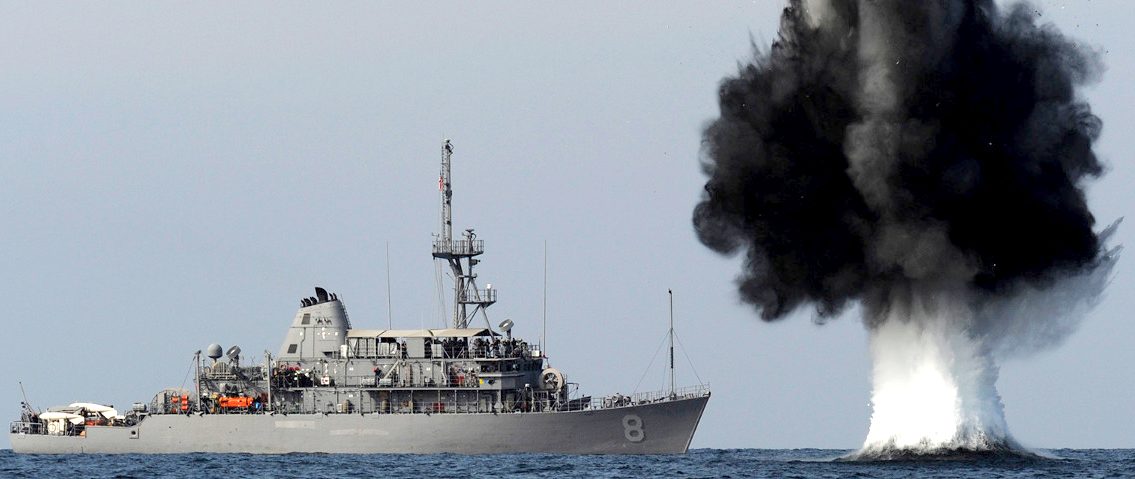
This
picture is an advertisement for drone minesweepers. the risk to human
life is unacceptable. Not only that but the methods used are straight
out of the Ark. It makes us wonder if any of the usual naval
subcontractors have any bright boys with ideas at all.
POPULAR MECHANICS - APRIL 2013 COMING ARMADAS OF MINE HUNTING ROBOTS
Nineteen U.S. Navy ships have sunk since 1945, and 15 of them fell prey to sea mines. To put a stop to it, the U.S. Navy wants someone to build its first unmanned minesweeping system, the Unmanned Influence Sweep System (UISS). Its mission: to find marine mines and detonate them safely—with humans kept out of harm's way. The Navy hopes to have this technology at sea within five years.
If a navy can't control the sea with ships, mines are a cheap and deadly alternative. In October 1950, for examples, North Korea laid 3000 mines off its eastern coast, enough to prevent 250 United Nations ships from carrying out an amphibious assault on Wonsan that might have changed the outcome of the war. "We have lost control of the sea to a nation without a navy," Rear Adm. Allen E. Smith lamented then.
Sixty years later, South Korea blamed a floating North Korean mine for the sinking of a
South Korean naval vessel that was patrolling the sea border near Baengnyeong Island. China, a longtime friend of North Korea, has over 80,000 mines ready to deploy should a war break out. Or consider the Strait of Hormuz, the narrow passage between the Persian Gulf and the Arabian Sea through which a significant amount of the world's petroleum must pass—an area that Iran has threatened to mine.
The Navy estimates that 50 countries are currently holding about a million mines of 300 different kinds. Then there are underwater improvised explosive devices (IEDs), seagoing versions of the deadly roadside bombs used by al-Qaida in Afghanistan and Iraq. Terrorist groups can build these devices with just a few hundred dollars' worth of materials, but they're just as devastating as their more sophisticated cousins.
Robotic ships could clear such devices, and the Navy expects to use them by 2017. So how do you blow up a mine without blowing up the minesweeping robot?
A small, unmanned surface craft could tow an underwater system designed to trigger mines from a safe distance. The system emits magnetic and acoustic signals that mimic the signature of a passing ship and trick the mine into detonating, while the real ship waits safely out of range. The Navy calls this an influence sweep, as opposed to a mechanical sweep that cuts mines' mooring cables and tags them for disposal by Explosive Ordnance Disposal (EOD) teams.
Although the process uses sound and magnetic signals rather than physical contact to detonate mines, there is some risk of damage to the equipment. The Navy's requirements for the UISS specify that it must be "sufficiently rugged to survive mine explosions"—the UISS is intended as a long-term, reusable system, not a suicidal decoy.
The system must carry out its mission without steering help from anyone aboard the ship. An operator would program the bot to transit to specific coordinates and deploy the underwater system, but monitor from a safer vantage point as the bot completes its sweep. Leonard says this semiautonomous setup will reduce the manpower needed for minesweeping operations "while keeping the sailor out of the minefield."
The UISS may operate in conjunction with the 20-foot-long, torpedo-shaped Knifefish, a semiautonomous mine-hunter designed to scan the seafloor for buried mines. Knifefish will use sonar to detect underwater objects and compare them with a database of known mines stored in its onboard
computer. When it returns from its mission, the Knifefish will upload the locations of potential mines to computers aboard a littoral combat ship (LCS), a Navy ship designed to operate in shallow coastal waters.
The UISS and the Knifefish will be only part of a mine countermeasures module carried aboard LCSs, the Navy says. There will also be a towed sonar device for remote mine detection, as well as an MH-60S helicopter to carry the Airborne Laser Mine Detection System and Airborne Mine Neutralization System.
But what holds up the UISS could be the LCS, the Navy's platform for these antimine robots. The program continues to face debate over its budget and its importance in the fleet.
During bidding for the Littoral Combat Ship contract, both Lockeed Martin and Austal bid well below
the Pentagon's expectations, so the Navy made the now-controversial decision to order both versions. This strategy offered the advantage of faster delivery; each contractor is able to complete two ships each year, so accepting both bids effectively doubles that delivery rate. However, Navy officials recently revealed that building two versions of the LCS will increase each vessel's lifetime maintenance costs by about $400,000, for ships that already cost $440 million each to build—about twice the original budget.
The Lockheed Martin version became the Freedom class, led by USS Freedom (LCS-1). Austal's version became the Independence class, led by USS Independence (LCS-2). USS Fort Worth (LCS-3), the second Freedom-class ship, entered service in 2012, and the next Independence-class LCS, USS Coronado (LCS-4), is expected later in 2013.
Popular
Mechanics the-coming-armada-of-mine-hunting-robots
NEW YORK TIMES NOVEMBER 2012
Washington
- The Navy says it has come up with plans to increase its deployments of the latest generation of robotic equipment that can detect and remotely detonate mines as a way to help guarantee a continued — and credible — countermine ability in waters off Iran into next year and beyond, when the number of minesweeping ships on patrol may be reduced.
Two new crews will join the 10 that now rotate duty on the eight minesweepers in the Persian Gulf region. Those additional crews entering the deployment cycle should help relieve the stress on the sailors and their families, while sustaining a high tempo of mine-clearing missions, Navy officers said.
Four of the minesweepers now on patrol in the Middle East are permanently based in Bahrain, home of the Fifth Fleet.
But four others, sent to the region during the summer as tensions with Iran escalated, may be ordered back to their home port in San Diego next year if the situation in the region allows. The Navy wants those vessels back in the Pacific Ocean to meet requirements of President Obama’s rebalancing of a military and diplomatic focus on Asia.
Defense Secretary Leon E. Panetta has declared that any action by Iran to block free transit of oil and other commerce in the Persian Gulf and the
Arabian Sea would be a “red line,” meaning an unacceptable action that would be countered with an American response.
But Pentagon and Navy officials are well aware that Washington’s ability to affect Iran’s behavior is based in part on Tehran’s assessments of American military ability. Defense Department officials are concerned that the Iranian leadership may view American military might as strictly a numbers game, counting only the warships on patrol.
To counter that potential perception, Navy officers have highlighted the effectiveness of the expanded presence of new robotic mine countermeasures being deployed by helicopters and aboard ships.
“We are getting precise tools that effectively, surgically, counter these mines, that map potential mine danger areas and then put our forces on them to kill them,” said Rear Adm. Frank A. Morneau, the Navy’s deputy director for expeditionary warfare.
“We hope to have capabilities even better than eight ships in the gulf,” he added. “We can really reduce the anti-access, area-denial capability of the mine. We are making it impotent.”
Pentagon officials — in views affirmed by academic national security analysts — say that while Iran might be able to close the Strait of Hormuz with mines, the effort would not be effective at halting traffic for more than a few days, given American and allied abilities.
In September, the United States and 29 other nations conducted the largest minesweeping exercise ever in the Persian Gulf region, a two-week drill that was also intended as a signal to Iran that the American military is not the only one working to ensure the flow of oil supplies.
In addition to the current technologies aboard mine-clearing ships and sonar sleds hauled through the water below MH-53 helicopters, the Navy is increasing the number of unmanned, remotely piloted systems deployed in the region.
Among them are the MK 18 underwater vehicle, which is a remotely piloted, torpedo-shaped vessel that searches for and identifies mines. Another new technology to be increased in the
Persian Gulf is the SeaFox mine neutralization system, a relatively inexpensive and expendable underwater drone that can approach a mine and detonate.
GIZMAG JULY 2012 - NEW ALGORITHMS IMPROVE EFFICIENCY OF MINE SWEEPING ROBOTS
In addition to human divers equipped with sonar cameras, the U.S. Navy has also trained dolphins and sea lions to search for bombs on and around vessels. All these methods are expensive and can’t always deliver the best performance in all environments. Robots would seem to be the obvious answer and underwater robots have been the focus of much research and development in recent years. Now researchers at
MIT have developed new algorithms to vastly improve the navigation and feature-detecting capabilities of these robots.
With the ultimate goal of designing completely autonomous robots that can navigate and map cloudy underwater environments without any prior knowledge of the environment and detect mines as small as 10 cm in diameter, Franz Hover, the Finmeccanica Career Development Assistant Professor in the Department of Mechanical Engineering, and graduate student Brendan Englot came up with algorithms to program a robot called the Hovering Autonomous Underwater Vehicle
(HAUV).
Getting a robot to provide a complete picture of a massive structure, such as a naval combat vessel, including small features such as bolts, struts and any small mines, is no easy task. And with mines as small as 10 centimeters (3.9 in) in diameter still powerful enough to cause serious damage to a ship, attention to detail is of the utmost importance.
“It’s not enough to just view it from a safe distance,” Hover says. “The vehicle has to go in and fly through the propellers and the
rudders, trying to sweep everything, usually with short-range sensors that have a limited field of view.”
To provide a detailed sweep of a ship's hull, the researchers took a two-stage approach. Firstly, the robot is programmed to swim in a square around the ship’s hull at a safe distance of 10 meters (33 ft), using its sonar camera to gather data that is used to produce a grainy point cloud. Although a ship’s large
propeller can be identified at this low resolution, it isn’t detailed enough to make out a small mine.
Additionally, the point cloud may not necessarily tell the robot where a ship’s structure begins and ends – a problem if it wants to avoid colliding with a ship’s propellers. To generate a three-dimensional, “watertight” mesh model of the ship, the researchers translated this point cloud into a solid structure by adapting
computer
graphics algorithms to the sonar data.
Once the robot has a solid structure to work with, the robot moves onto the second stage. This sees the robot programmed to swim closer to the ship, with the idea of covering every point in the mesh at spaces of 10 centimeters apart.
While the seemingly most obvious sweep pattern would be one strip at a time – much like mowing a lawn – the researchers came up with a more efficient approach. Using optimization algorithms the robot is programmed to sweep across the structures while taking into account their complicated 3D shapes. The researchers say this technique significantly shortens the path the robot needs to take to view the entire ship.
The team has field tested its algorithms by creating underwater models of the
Curtiss, a 183-meter (600-ft) military support ship in San Diego, and the Seneca, an 82-meter (269-ft) cutter in Boston. Tests on the system are continuing this month in Boston Harbor. With the U.S. Navy also developing autonomous hull-cleaning robots, there may soon be a number of robots keeping each other company on and around the hulls of ships.
“The goal is to be competitive with divers in speed and efficiency, covering every square inch of a ship,” Englot says. “We think we’re close.”
Hover and his colleagues have detailed their approach in a paper to appear in the International Journal of Robotics Research.
The video below shows the 3D coverage path taken by the HAUV when mapping the SS Curtiss using the new algorithms.
Source: MIT
Gizmag
mine-sweeping-robot-algorithms



R.
Admiral Thomas K Shannon (Commander) R. Admiral Lawrence "Larry" B Jackson
(Deputy Commander) and John S Thackrah (Executive Director) Military Sealift Command
NEW YORK TIME JAN 1985 - US NAVY TESTING ROBOT DRONES TO FIND &
DESTROY SEA MINES
The Navy is building a deep diving robot to take on one of the most dangerous of all military tasks - sweeping the seas of explosive mines.
In an effort to modernize its aging minesweeping forces, the Navy is introducing this and other new technologies and is in the process of building the first class of new minesweeping ships since the Korean War.
''The old minesweeping force used strictly mechanical equipment,'' said Cmdr. Arthur E. Oseicki, a Navy mine warfare specialist. ''This system allows us to increase safety for the ship's crew, and to do the mission quicker and more effectively.''
Both the mining of Nicaraguan harbors by anti-Sandinista insurgents and the mining of entrance to the Suez Canal last year demonstrated the continued military effectiveness of the century-old tactic of planting mines in the sea. The incidents also underscored the inability of the world's modern navies to combat this form of warfare. Although more than 20 major oil and
cargo ships were damaged by the mines in the Suez Canal, a major international effort to sweep the area turned up only one mine.
OIL COMPANIES TAKE LEAD
The inspiration for the new advances were supplied by American oil companies. In the early 1970's they found themselves unable to make
necessary structural maintenance on some deeply sunk off-shore oil
rigs. To meet this need, the companies financed the development of a combination
mini-submarine and robot that would do minor repairs and be able to survey the extreme depths of the giant rigs.
Naval planners adapted the mini-sub to mine warfare. The Navy's mini-sub system, which is being built by Honeywell Inc.'s Defense Systems division, is a small drone connected to the mother ship by an umbilical cord and directed by closed circuit television and sonar.
Preliminary tests of the system were completed in 1982, and the system will be fully operational this year. Navy officials said that, in
addition to reducing risk to a ship's crew, the robot will transform minesweeping from a guessing game into a precise skill.
According to Navy officials, the robot is put into action after a mine is detected by the mother ship's sonar. The minisub-robot, called a ''mine neutralization system,'' is then lowered into the water and directed to the vicinity of the mine by the mother ship's sonar. The robot's own
sonar then takes over, and guides it to the mine.
The system can then do a number of things, depending on the type of mine that has been discovered. If the mine is moored to the ocean floor by a cable or chain, the robot's cutters sever the cable, causing the mine to float to the surface where it can be destroyed by small arms fire. Contact mines, which are detonated by physically touching the ship, are usually deployed this way.
If the mine is of a more advanced magnetic or acoustic design, detonated by the vibrations or engine sounds or by the magnetic field of a
steel ship, the robot either plants a small, timed explosive charge in the sea bed near the mine and detonates it when the sub and mother ship have moved a safe distance away. Or, in the case of acoustic mines, it can transmit sounds at various frequencies that emulate the noises of a ship's engine.
Similar systems are under development for the navies of West Germany, France, Britain and
Italy.
USED TO SUPPLEMENT HELICOPTERS
The two new classes of minesweepers that are being built for the Navy will be capable of carrying the minisub-robot system, and the system will be standard equipment on the larger of the two classes.
The building of the new ships is a departure from the Navy's reliance on helicopters for minesweeping. By the mid-1960's the Navy had sold off its force of World War II vintage minesweepers. The specially designed Sikorsky RH-53D minesweeping
helicopter, which became the
workhorse of the mine force, operates much the way minesweeping ships do, but can cover a greater area.
The helicopter operates by dragging ''sleds'' rigged with either cable cutting devices or sound generators that imitate a ship's engine. The clearing of the
Suez Canal after the 1973 Arab-Israeli war was done by RH-53D helicopters.
''The Navy will now use a mix of the minesweeping helicopter and the surface minesweeper,'' Commander Osiecki said.
''We envision their use in different situations, in different conditions, and sometimes in tandem.''
The advantage of the robot is that it can go deeper and in much rougher waters than a helicopter's sled.
''The mine neutralization system is an advance, but it was not meant to replace the
helicopter,'' he said.
New
York Times 1985
Navy-is-testing-robot-drones-to-seek-and-destroy-sea-mines
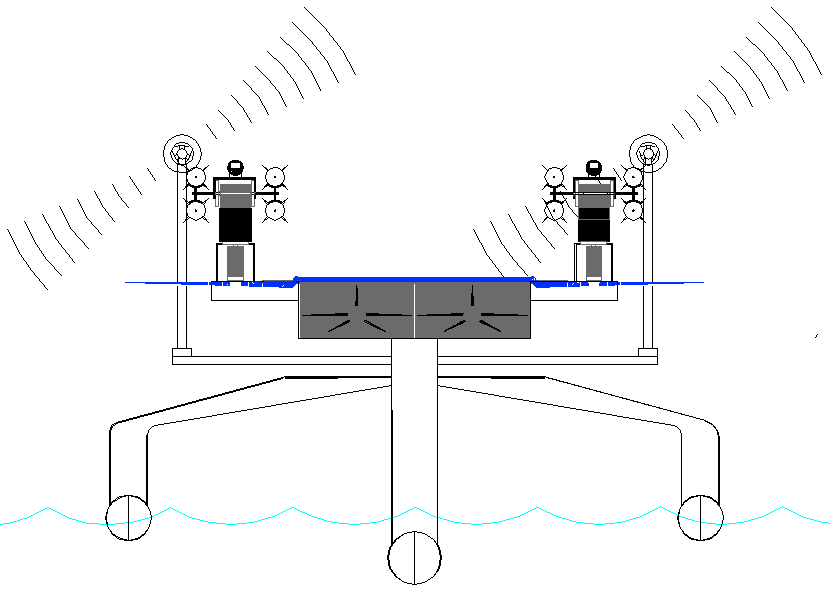
TRUE
AUTONOMY - Cost
effective mine disposal rests with fully autonomous unmanned drones that
are used in coordinated sweep cycles. The robot
ship concept above uses no diesel fuel to monitor the oceans autonomously (COLREGS
compliant) 24/7 and 365 days a year if necessary - only possible with the revolutionary
(patent) energy harvesting system. The
hullform is ideal for automatic release and recovery of ROVs
or towed arrays, alternating between drone and fully autonomous modes.
International development inquiries are welcomed. This zero carbon vessel
pays for itself in fuel saved every ten years.
LINKS
& REFERENCE
US
Navy Wikipedia
United_States_Navy UK
MOD Royal Navy tests
remote controlled minehunter Combat
and Survival UK news Royal Navy begins testing remote controlled
minehunter Arrse-news-story-royal-navy-tests-remote-controlled-minehunter http://www.uk.atlas-elektronik.com/
http://www.arrse.co.uk/community/threads/news-story-royal-navy-tests-remote-controlled-minehunter.212710/
http://www.combatandsurvival.com/news/uk/430-royal-navy-begins-testing-remote-controlled-minehunter
https://www.gov.uk/government/news/royal-navy-tests-remote-controlled-minehunter
http://www.defense.gov/
http://www.navy.com/
http://en.wikipedia.org/wiki/United_States_Navy
http://www.navy.mil/
http://www.nytimes.com/2012/11/15/world/middleeast/navy-sends-more-robotic-mine-clearing-systems-to-persian-gulf.html
http://www.popularmechanics.com/technology/military/robots/the-coming-armada-of-mine-hunting-robots-15381806
http://www.gizmag.com/mine-sweeping-robot-algorithms/23337/
https://news.vice.com/article/the-us-navy-may-battle-deadly-naval-mines-with-quadcopter-drones
http://www.nytimes.com/1985/01/29/science/navy-is-testing-robot-drones-to-seek-and-destroy-sea-mines.html
US
Department of Navy Research, development & Acquisition - http://acquisition.navy.mil/ US
Fleet Forces Command - http://www.cffc.navy.mil/
US
http://www.msc.navy.mil/
http://en.wikipedia.org/wiki/Naval_Oceanographic_Office
http://www.thefreedictionary.com/autonomous
http://en.wikipedia.org/wiki/Autonomy
|











